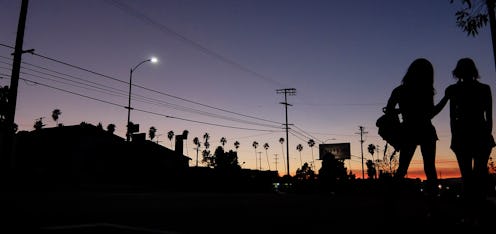
Back at Sundance in January, the indie dramedy Tangerine was one of the most talked-about films at the festival. Six months later, it's finally getting released, with a Jul 10 premiere. There's plenty of reason to flock to theaters; part of the film's acclaim stems from its unique story, in which two transgender prostitutes set out to teach a lesson to a cheating boyfriend. Tangerine also sparked conversation for another reason, though: its incredible cinematography. Incredibly, Tangerine was made totally on an iPhone — and the visual result is so compelling that audiences won't be able to turn away even for a second.
How impressive is it the movie was made not with the normal cameras and equipment, but with something as simple as a cell phone? Admittedly, most of us use our iPhones' video functions for our own personal entertainment as opposed to any lofty artistic goals. But for director Sean Baker, the smartphone's capabilities presented a solution to a major creative dilemma. The filmmaker told The Verge that he wanted to make a movie based on the red-light district near his home on Santa Monica Boulevard, but he immediately discovered a conflict between his desire for high-quality video footage versus the reality of a small budget. Baker began searching for solutions and came upon a Vimeo page which featured films made entirely with iPhones. The cinematic quality of the films impressed Baker, and he realized that it was possible to create a visually beautiful film utilizing existing resources which wouldn't break the bank. With a little creativity, Baker perfected the recipe for Tangerine.
Baker's film hinged on two iPhones, one 32G and one 64G. On the topic of using iPhones to shoot, Baker said, "It was surprisingly easy." The production team filmed using both phones at the same time to portray different angles, and Baker told the New York Times that they captured some moving shots by filming with one hand as he rode his bike. They also utilized Steadicams to stabilize the iPhones during filming. The human hand is never perfectly still, so Baker attached Steadicam rigs to the phones in order to prevent shaky shots.
Another tool which proved invaluable to the production was an anamorphic adaptor lens from a company called Moondog Labs. According to CultofMac.com, Baker reached out to the company after finding out that they were making a prototype for an anamorphic lens that could fit onto an iPhone. Anamorphic lenses create the appearance of a wide-screen film, and so this product allowed Baker to achieve a "cinematic look." He hailed the discovery of the adaptor as the deciding factor to move the film into production, saying, "It was the reason I could move forward."
Finally, Baker used the app Filmic Pro to control focus, aperture, and color temperature. In post-production, the team added a digital grain to give the footage the appearance of actual film. They also played with intense levels of color saturation in order to highlight the colorful nature of the two main characters and the world in which they live. The most prominent hue in the film? Orange — or, more accurately, tangerine.
With a little bit of money but a LOT of inventiveness, Baker managed to create an unforgettable film which has the appearance of a big-budget feature. Sort of puts your Snapchat videos to shame, huh?
Image: Magnolia Pictures